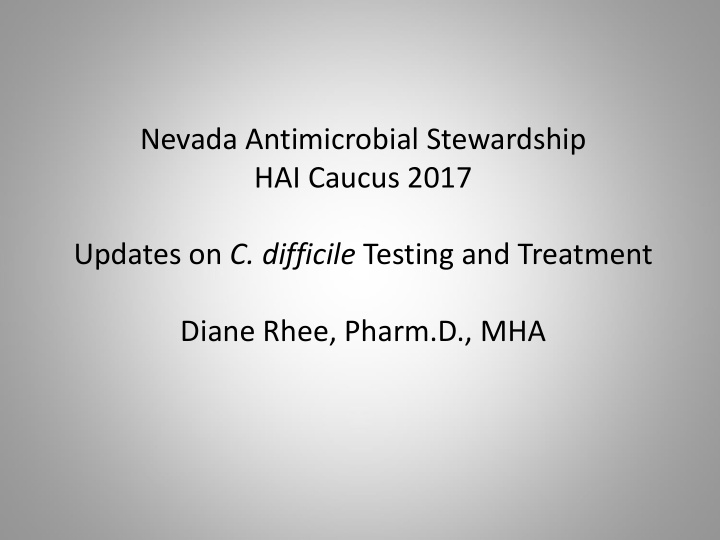



Nevada Antimicrobial Stewardship HAI Caucus 2017 Updates on C. difficile Testing and Treatment Diane Rhee, Pharm.D., MHA
All Data is Transparent www.hospitalsafetygrade.org 2
Merck: Economic Model of C. difficile • Utilizing 2014 data, predicted 606,058 C. difficile episodes HO CO 25.5% of HO 34.3% CO from LTC $4.7 billion $725 million estimated costs estimated costs $3.2 billion initial $647 million initial $1.5 billion $77 million recurrent recurrent Desai et al. BMC Infectious Diseases (2016) 16:303
Differential Diagnosis: Diarrhea
Clinical Diagnosis Diarrhea ≥3/24hrs Positive Test Usually no fever, High WBC unless severe
Laboratory Tests Test Sensitivity Specificity Comments Enzyme Immunoassay Easy to test, cheap, quick 63-94% 75-100% (EIA) for toxins A/B turnaround Labor-intensive, long turnaround Culture 90-100% 98-100% time, cannot differentiate toxin producing vs. non-toxin Only detects toxin B, requires Cell Cytotoxicity Assay 67-100% 90-100% technical expertise, expensive, long turnaround time Easy to test, cheap, quick Glutamate 58-68% 94-98% turnaround, need confirmatory Dehydrogenase (GDH) test Polymerase Chain Easy to test, quick turnaround, 92-97% 100% Reaction (PCR) expensive
Current Issues Around Testing • Focus is CO vs. HO ‒ Diarrhea within 4 days of admit CO priority to get test ‒ If test is not done within 72 hours of order automatic discontinuation ‒ Do not repeat test within 7-10 days, or for test of cure SNF not accepting patients without test of cure • Colonization vs. infection ‒ PCR is “too” specific too many patients lab-identified as C. difficile when not infected over-reporting and over-treating ‒ Labs evaluating GDH / EIA again, with PCR as confirmatory only as needed ‒ Administration asking about testing for C. difficile colonization upon admit • BI/NAP1/027 ‒ Not many labs have capabilities to test ‒ Other rapid diagnostics with C. difficile testing ‒ What are clinical implications?
ESCMID 2016 Diagnostic Guidelines for C. difficile
3-Step Testing https://www.nuh.nhs.uk/media/1069241/new_cdiff_testing_and_reporting.pdf
EIA vs. 2 Step vs. PCR Study • Cedars Sinai evaluated differences in testing methodologies from 2008-2011 Dec 2008-Nov 2009: Dec 2009-Apr 2010: GDH + May 2010: PCR, repeat within PCR 7 days cancelled by lab EIA Toxin A/B 17.5% (+) result (23.2% increase, p = 20% (+) result (41.1% vs. EIA, 14.2% (+) result 0001) P,0.0001), 14.6% vs. 2ST, p = 0.02) 32.3h time to test result 26.5h time to test result 17h time to test result No difference in empiric treatment vs. Ave # treatment days: 1.65 days Ave # treatment days: 2.12 days EIA (22.2% reduction, p<0.0001) Patients with GDH (+), PCR (-) received 4+ days of CDI treatment: 18.7% 4+ days of CDI treatment: 25% more empiric therapy (58.6% with >4 (p<0.0001) days of tx) Clin Microbiol Infect 2014; 20: 65 – 69
C. DIFFICILE – ANTIMICROBIAL STEWARDSHIP AND TREATMENT
2010 SHEA/IDSA Guidelines for C. difficile
CDI Stewardship Metrics
Stewardship Thoughts Around NAP1/BI/027 • Known to increase 027 strain with FQ exposure decrease FQ use • Known hypervirulence with potential worse patient outcomes ‒ What about 078 strain? • Most probable treatment: vancomycin PO does this increase VRE? ‒ Fidaxomicin did not show better outcomes in 027 ‒ Metronidazole in 027 clinical outcomes unsure ‒ Surotomycin – possibly better for 027? • Clinical implications unsure most likely IC issue rather than clinical J Antimicrob Chemother. 2007Jul;60(1):83-91. Epub 2007 May 5.
Fidaxomicin
Fidaxomicin Global Cure
Fidaxomicin MUE 120% Percent recurrence Percent died 100% 80% 60% 40% 20% 0%
Fecal Transplant
OpenBiome
Current Issues Around Fecal Transplant • How many doses need to be administered? • Optimal route of administration? • Frozen vs. Fresh samples? • Bowel prep ± vancomycin taper? • Follow-up?
Hospital Protocols for Fecal Transplant • UNC: https://www.med.unc.edu/gi/faculty-staff-website/patient- education/1FecalTransplantProtocols.pdf • U of Indiana: http://medicine.iupui.edu/gast/programs/fecal-microbiota • Stanford (using Openbiome): http://med.stanford.edu/bugsanddrugs/guidebook/jcr:content/main/pan el_builder_1454513702/panel_0/download_1985839819/file.res/Openbi omeFMTprotocol_6-1-15.pdf • Johns Hopkins: http://www.hopkinsmedicine.org/gastroenterology_hepatology/clinical_s ervices/advanced_endoscopy/fecal_transplantation.html • UW: https://www.uwhealth.org/healthfacts/dhc/7878.pdf • Cleveland Clinic: https://health.clevelandclinic.org/2014/05/despite-the- ick-factor-fecal-procedure-works-wonders/
Bezlotoxumab (Zinplava) • Actoxumab neutralize toxin A, bezlotoxumab neutralize toxin B – Fully human monoclonal antibodies • MODIFY I and II trials: 322 sites, 30 countries, Nov 1, 2011-May 22, 2015 • Primary Outcome: recurrence within 12 weeks in mITT – Tx: PO metronidazole, PO vancomycin/fidaxmicin +/- IV metronidazole x 10-14d – Day 1, 60-min infusion: 1:1:1 bezlotoxumab 10mg/kg vs. actoxumab+bezlotoxumab 10mg/kg each vs. NS – >90% power to detect 9-10% difference in recurrence
Bezlotoxumab (Zinplava) Results • 2559 patients in mITT, 2174 patients completed 12 weeks – Median age: 66 years, 86% white, 56% women, 68% inpatient – Tx: 47% metronidazole, 48% vancomycin, 4% fidaxomicin • NNT to prevent 1 recurrence:: 10 – Age >65yo or previous CDI: NNT 6
Recurrent C. difficile Infection, 12 weeks
Nevada Antimicrobial Stewardship HAI Caucus 2017 Updates on C. difficile Testing and Treatment Diane Rhee, Pharm.D., MHA
Recommend
More recommend